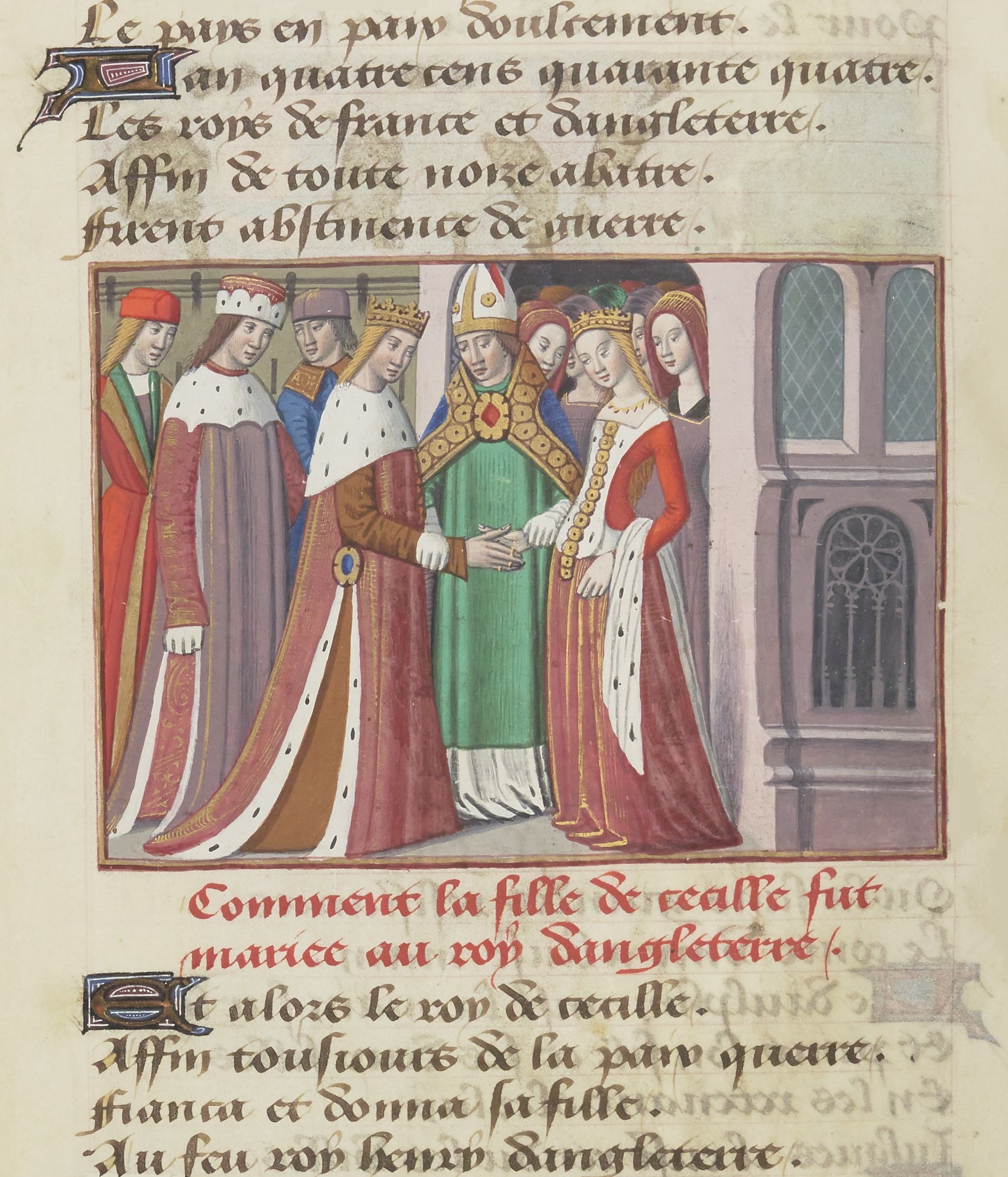The success of the HBO show Game of Thrones, based on George R. R. Martin’s series of novels by the same title, has renewed interest in the English Wars of the Roses. Martin loosely based the political tangle at the heart of Game of Thrones on the bloody struggle in the mid-fifteenth century between factions of the Plantagenet family for control of the English throne.
While traditional histories of the Wars of the Roses have focused on the men vying for the throne and the battles fought to that end, there has been a recent spate of interest in the women of the houses of Lancaster and York whose maneuvers behind-the-scenes may have been as important to the outcome of events as the men’s on the battlefield. In Blood Sisters, Sarah Gristwood focuses on seven of these powerful women: Marguerite of Anjou, Cecily Neville, Margaret Beaufort, Elizabeth Woodville, Margaret of Burgundy, Anne Neville, and Elizabeth of York.
 Blood Sisters is arranged chronologically, beginning with the tumultuous marriage of Marguerite of Anjou and Henry VI in 1445 (depicted to the right) and following women connected to both the ruling Lancaster and claimant York branches of the Plantagenet family tree. Both the Lancasters and Yorks were descended from Edward III and therefore cousins to one another, which explains why participants called it The Cousins War. Blood Sisters ends as it began in the prologue, with Elizabeth of York, who united the two branches again on the throne and ended three decades of fighting with her marriage to the Lancastrian Henry VII after the latter’s victory at the Battle of Bosworth.
Blood Sisters is arranged chronologically, beginning with the tumultuous marriage of Marguerite of Anjou and Henry VI in 1445 (depicted to the right) and following women connected to both the ruling Lancaster and claimant York branches of the Plantagenet family tree. Both the Lancasters and Yorks were descended from Edward III and therefore cousins to one another, which explains why participants called it The Cousins War. Blood Sisters ends as it began in the prologue, with Elizabeth of York, who united the two branches again on the throne and ended three decades of fighting with her marriage to the Lancastrian Henry VII after the latter’s victory at the Battle of Bosworth.
Gristwood makes good use of the fragmentary sources available to medieval scholars, transitioning smoothly between exposition of events and discussion of their significance. Her treatment of the women is sympathetic as she attempts to recreate and understand their lives and their impact on others. Gristwood writes after a description of Margaret Beaufort’s spiritual practices taken from her cleric biographer, “It is the picture of what was for the time a perfect piety. . . . Margaret participated in all the old popular practices and would surely have been horrified by any suggestion that the inevitably questioning nature of her own intelligent interest . . . could have sown the seeds of her grandson Henry VIII’s eventual break from the Roman Catholic Church and his creation of an independent Church of England” (305). Gristwood carries this signature interpretive style throughout Blood Sisters, expertly drawing connections between family members and relishing details about the individuals’ lives that she is able to pull from the sources.
 The downside to such a deep reading of sources is the temptation to make claims that, unless more sources come to light, historians cannot prove. For example, in discussing Anne Neville, Gristwood admits that “there are a huge number of question marks over Anne, more than any other woman in our story. . . . to modern eyes, there is something worrying in Anne’s notable absence from the records—notable even by the standards of a fifteenth-century wife.” Gristwood speculates that because Anne’s husband Richard III (pictured left) needed her money and connections to the York branch of the family, “perhaps that need made him all the more determined to limit her autonomy” (125). The occasional speculation, however, does not detract from the overall merit of Gristwood’s study, nor does she make any claims that are entirely implausible.
The downside to such a deep reading of sources is the temptation to make claims that, unless more sources come to light, historians cannot prove. For example, in discussing Anne Neville, Gristwood admits that “there are a huge number of question marks over Anne, more than any other woman in our story. . . . to modern eyes, there is something worrying in Anne’s notable absence from the records—notable even by the standards of a fifteenth-century wife.” Gristwood speculates that because Anne’s husband Richard III (pictured left) needed her money and connections to the York branch of the family, “perhaps that need made him all the more determined to limit her autonomy” (125). The occasional speculation, however, does not detract from the overall merit of Gristwood’s study, nor does she make any claims that are entirely implausible.
The supplementary information she includes in addition to the text—a glossary of names, a simplified family tree, a map of England, a thorough index and a selected bibliography—are useful in keeping the sea of Margarets, Elizabeths, Richards, Edwards, and Henrys straight. The decision not to footnote the text, while keeping the page layout clean, means that the reader is required to flip to the back of the book to check references, which are organized by page number and sentence excerpt. This citation style makes it occasionally difficult to follow Gristwood’s reasoning or to tell which of Gristwood’s assertions are well-supported in the sources since most pages have only one reference and many have none at all. The sources on some of the women are rather thin, and one wonders to what extent Gristwood was forced to extrapolate in order to fill out their chapters.
Blood Sisters joins Philippa Gregory’s The Women of the Cousins’ War (January 2013) and Alicia Carter’s The Women of the Wars of the Roses (August 2013) in catering to current interest in women’s part in the Cousins’ War, although Gristwood is more ambitious than Gregory or Carter in taking on seven women rather than three as both Gregory and Carter do. Gristwood’s scope is beneficial, however, in offering the reader a broad view of the battles for the English throne fought in back rooms and throne rooms instead of on horseback.
 Gristwood opens Blood Sisters with a description of Elizabeth of York’s funeral (who is pictured right), and the passages in which Gristwood recreates medieval events are among the best in the book. Her evocative prose and ability to weave a variety of disparate sources into a cohesive narrative make Blood Sisters a pleasure to read, much like her other books Arbella: England’s Lost Queen (2005) and Elizabeth and Leicester: Power, Politics and Passion (2007).
Gristwood opens Blood Sisters with a description of Elizabeth of York’s funeral (who is pictured right), and the passages in which Gristwood recreates medieval events are among the best in the book. Her evocative prose and ability to weave a variety of disparate sources into a cohesive narrative make Blood Sisters a pleasure to read, much like her other books Arbella: England’s Lost Queen (2005) and Elizabeth and Leicester: Power, Politics and Passion (2007).
Sarah Gristwood’s Blood Sisters is an accessible introduction to a complex conflict. Her focus on the women of the Wars of the Roses offers an engaging entry into the personality-driven dynastic struggle that rocked the English throne for the better part of three decades, while her descriptions of the women make them come alive for the reader in a way that not all histories manage. Since Blood Sisters is intended for a popular audience, scholars may take issue with the lack of footnotes and the unwieldy citation format, but Blood Sisters is not meant to be an academic account of the Wars of the Roses. Instead, Gristwood offers a fascinating account of the Cousins’ War for the reader interested in the dynastic machinations of the most powerful women of their day.
